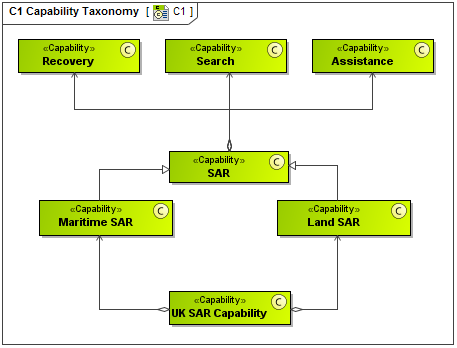Description
The C1 Capability Taxonomy view covers capabilities and the hierarchical relationships between them. It specifies all the capabilities that are referenced throughout one or more architectures – i.e. one C1 may provide the definitive list of capabilities for a number of logical and resource architectures. In NAF, Capabilities are ‘enduring’, that is they are intended to provide an enduring framework across the lifetime of one or more enterprises. This means that it is feasible to develop a capability taxonomy that will apply to all Enterprise Phases listed in a C2, and an C1 may even cover more than one logical / resource architecture.
The capabilities may be organized into specialization hierarchies (taxonomies). A capability taxonomy persists over time (an architect may wish to specify historical, current or future capability) and may be referenced by multiple architectures.
In NAF, a capability is a description of an ability to do something. In C1, the capabilities are only described in the abstract – i.e. C1 does not specify how a capability is to be implemented. A C1 is most commonly structured as a specialization hierarchy of capabilities, with the most general at the root and most specific at the leaves. Measures of effectiveness may be specified for each capability. Note that measures of effectiveness are inherited down a capability taxonomy.
A C3 is the view that describes dependencies between the capabilities shown in the C1 taxonomy.
The C1 view may be used to:
- Identify an existing and required capabilities.
- Source for the derivation of cohesive sets of KURs.
- Provide a reference capabilities for multiple architectures.
Implementation
The C1 view can be represented using a C1 Capability Taxonomy diagram which is based on the UML Class diagram.

- Capability
- Exhibits
- Climate
- Environment
- Environment Property
- Light Condition
- Location